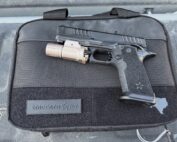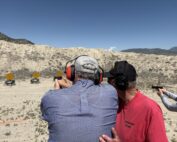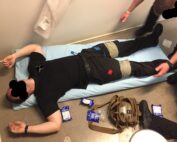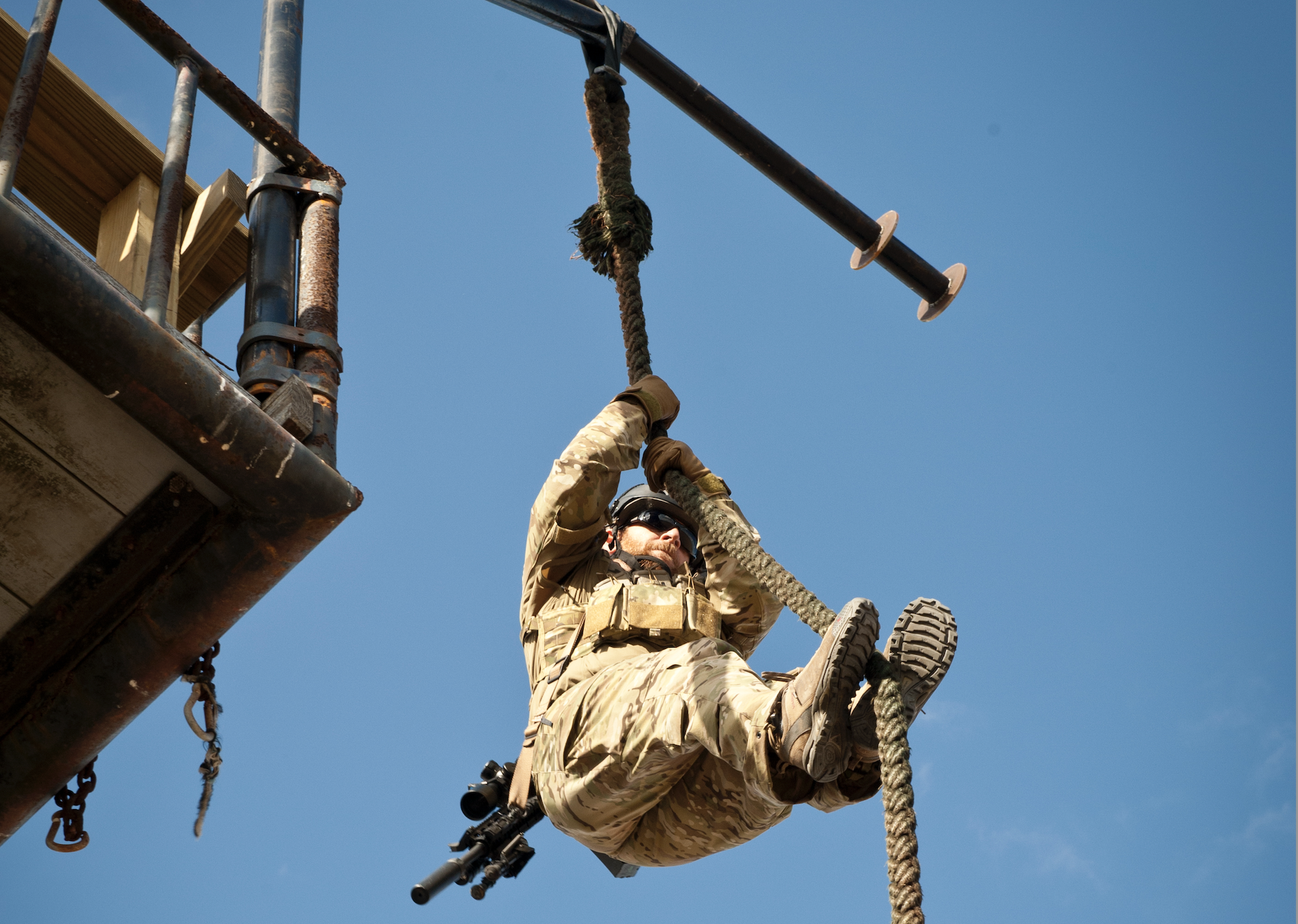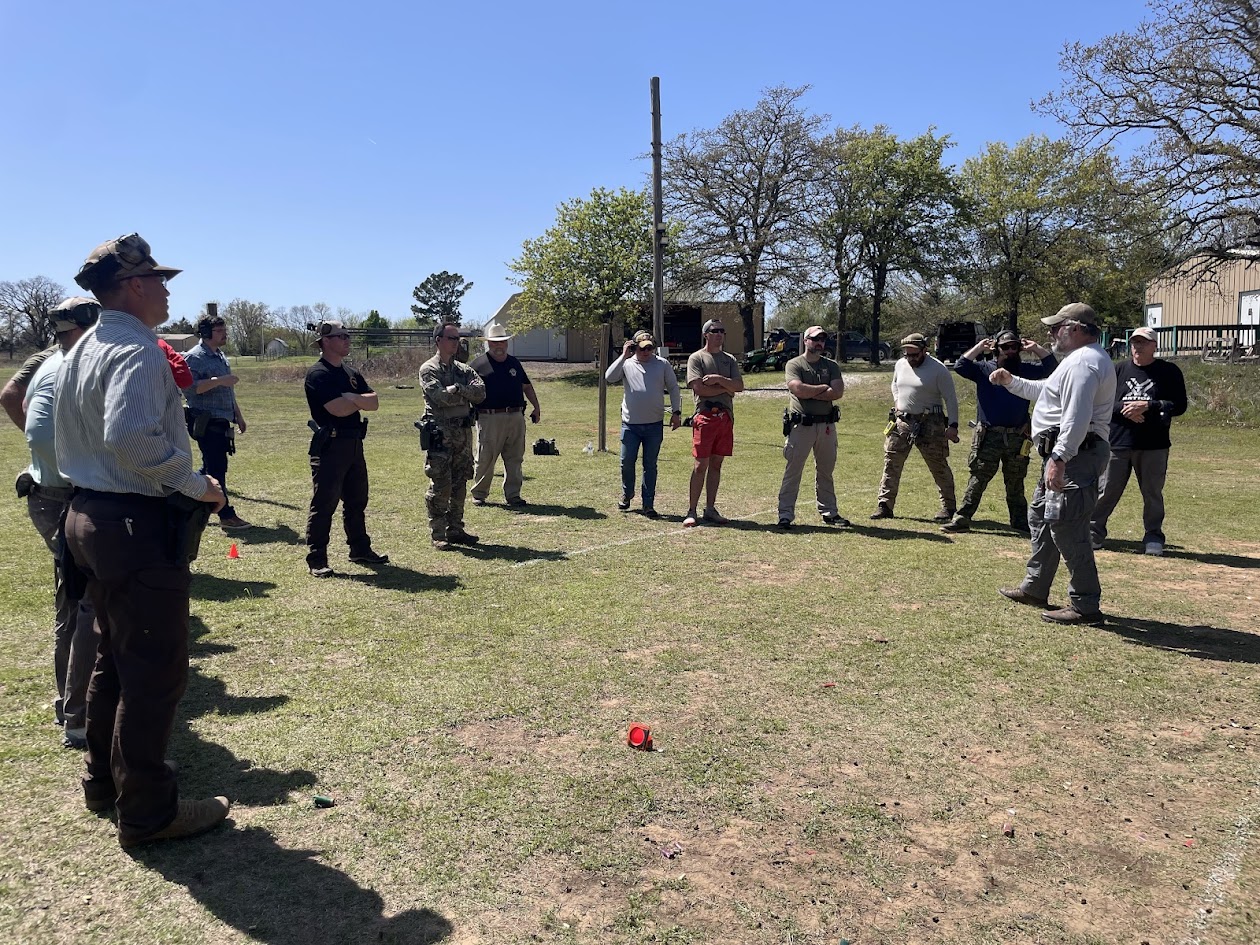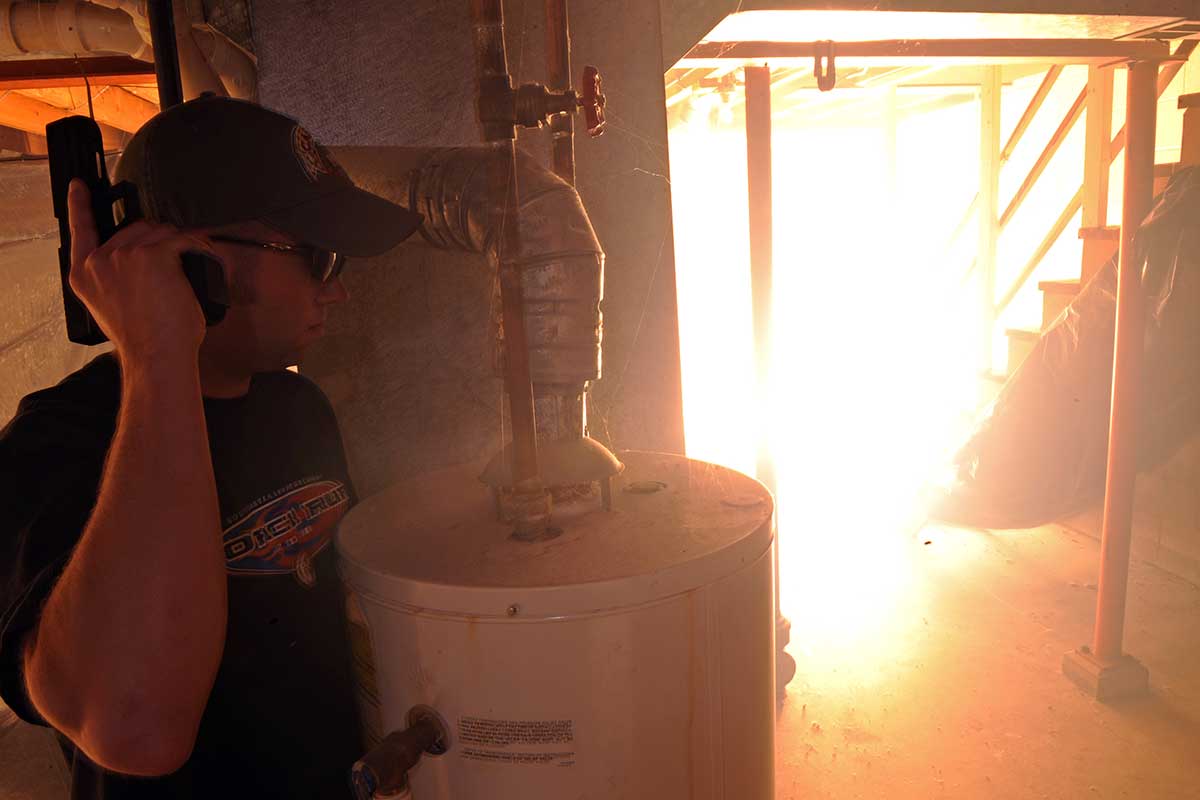
AC-122320-Flashbang-TB-2-800
The noise flash diversionary device (NFDD), also commonly referred to as a flash sound diversionary device (FSDD), diversionary device, flash grenade or flashbang, is an essential tool of the trade for tactical teams. NFDDs are designed to produce dramatic pyrotechnics that are intended to provide a brief distraction without causing permanent injury.
HISTORY OF THE NFDD
The world’s first grenades appeared in the Eastern Roman (Byzantine) Empire shortly after the reign of Leo III (717-741 AD). Made of clay and later glass, they were incendiary grenades that employed Greek fire. The first explosive grenades may be traced back to China during the Song Dynasty (960–1279 AD), when soldiers packed gunpowder into ceramic or metal containers.
Explosives were known in Japan from the time of the Mongol Invasions in the 13th Century. The ninja of feudal Japan are said to have used flash bombs to blind and distract their enemies. It was not until the 17th Century that explosive grenades appeared in Europe.
The British Special Air Service (SAS) is credited with the development of the first modern NFDD in the early1970s and the development and refinement of tactics for their employment. The SAS subsequently trained special operations forces (SOF) in the U.S. and several allied countries in the use of NFDDs for counter terrorist (CT) operations.
The first explosive grenades may be traced
back to China during the Song Dynasty
The first documented operational use of a NFDD was by Israeli commandos during Operation Thunderbolt to rescue passengers of a hijacked Air France jetliner at Entebbe, Uganda on 3 July 1976. Operation Thunderbolt is retroactively known in Israel as Mivtsa
Yonatan (Hebrew for Operation Jonathan) in honor of Lt. Col Yonatan Netanyahu, leader of the ground assault unit who was killed in action during the raid.
U.S. law enforcement agencies adopted NFDDs from the military. The Los Angeles Police Department D Platoon (SWAT) was one of the first U.S. law enforcement tactical teams to employ NFDDs. The LAPD’s first flashbang was a M116A1 Modified Hand Grenade Simulator, that had its charge reduced by the LAPD Bomb Squad. Today, it would be difficult, if not impossible, to find a tactical team anywhere in the country that does not have NFDDs in its tactical toolbox.
LIFESAVER OR LIABILITY
NFDDs can be either a lifesaver or a liability, depending on how they are employed. When properly employed, NFDDs are reasonably safe. When improperly employed, they have the potential to cause serious bodily injuries and property damage.
Although NFDDs have proven to be of extremely low lethality over many years of tactical use, several deaths have been attributed to their use. In 1984, a Los Angeles, California woman was killed when a flashbang went off between her back and a wall.
In 1989, police in Minneapolis, Minnesota, conducted a drug raid at the home of an elderly couple after a bad tip from an informant. The flashbangs used in the raid set the home on fire, resulting in the death of the couple from smoke inhalation.
In 2003, a woman died from a heart attack after police deployed a flashbang at her residence in Harlem, New York.
In 2011. A 28-year veteran Charlotte-Mecklenberg, North Carolina SWAT officer was killed when a flashbang went off in close proximity to his torso. Also in 2011, a man died in a fire that was apparently sparked by a flashbang deployed through a window during a raid of a home in Greenfield, California.
THE COURTS
In Kirk v. Watkins, 182 F.3d 932, 1999 WL 381119 (10th Cir. June 11, 1999), the United States Court of Appeal for the 10th Circuit stated that, “The use of a flashbang device is neither per se objectively reasonable nor unreasonable. The reasonableness of its use depends on the facts and circumstances of each case.”
In Boyd v. Benton County, City of Corvallis et al, 374 F.3d 773 (9th Cir. 2004), the United States Court of Appeal for the 9th Circuit held that the use of a flashbang while executing a warrant may constitute excessive force under the 4th Amendment. The Court stated “…given the inherently dangerous nature of the flash-bang device, it cannot be a reasonable use of force under the Fourth Amendment to throw it “blind” into a room occupied by innocent bystanders absent a strong governmental interest, careful consideration of alternatives and appropriate measures to reduce the risk of injury.”
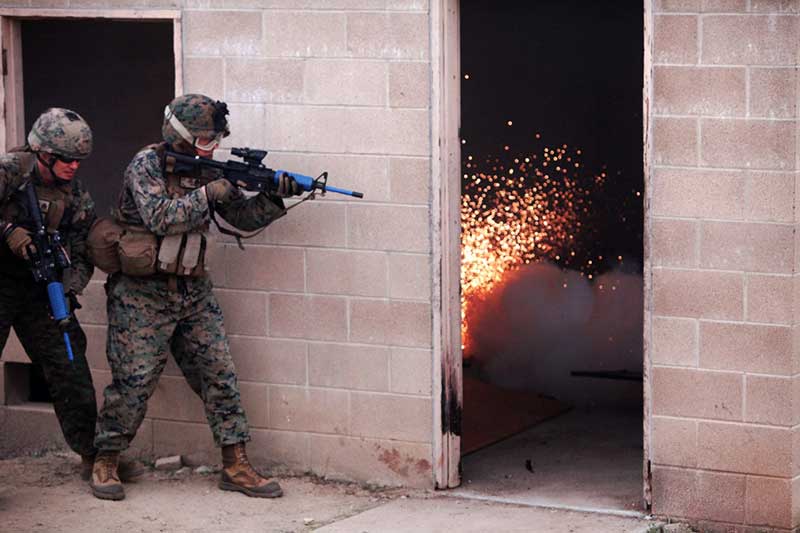
Marines with 2nd Battalion, 1st Marines prepare to clear a building after throwing a flashbang aboard Camp Pendleton, California in 2014. Photo: US Marine Corps Photo by Lance Cpl. Joshua Murray / Released.
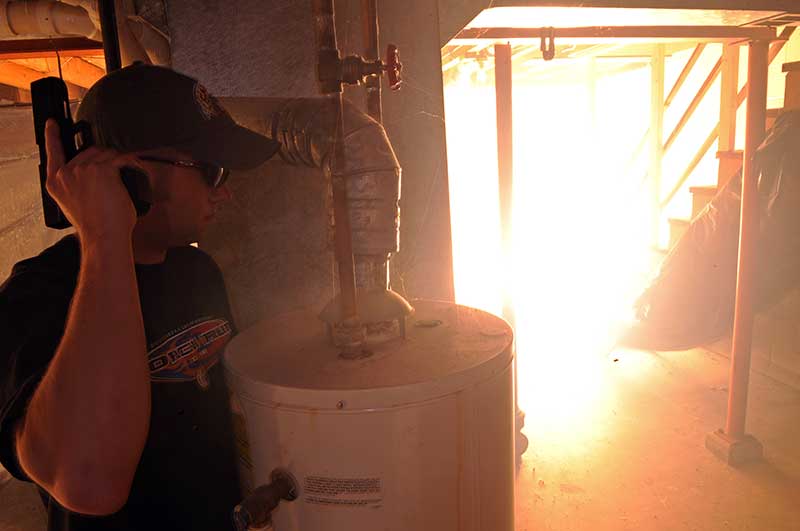
A flashbang deflagrates in the basement of a house where Ryan McCandless, a Rapid City, S.D., police officer, poses as an armed perpetrator for a special weapons and tactics exercise Sept. 12, 2008, at Ellsworth Air Force Base, SD. Photo: US Air Force photo by Senior Airman Marc I. Lane

Los Angeles Police Department D Platoon (SWAT) team members breach a room and engage hostile targets in a training exercise focusing on visit, board, search, and seizure (VBSS) tactics aboard maritime vessels. D Platoon was one of the first US law enforcement tactical teams to employ NFDDs. Photo: US Navy photo by Mass Communication Specialist 3rd Class Kristopher Kirsop / Released.
A sound legally defensible policy and proper training are key to the safe and effective employment of NFDDs. Most of the injuries that occur are the direct result of operator error. Operator error can almost always be linked to a failure in training. Training not only saves lives, it’s your first line of defense in court.
A municipality may be held liable for a violation of rights that results from a failure to adequately train its employees if that failure represents a deliberate indifference on the part of the municipal policy.
In City of Canton, Ohio v. Harris, 499 US 378, 103 L. Ed. 2d 412, 109 S. Ct. 1197 (1989), the United States Supreme Court stated “Failure to train may be fairly said to represent a policy for which a municipality is responsible and for which it may be held liable where injury results, if in light of the duties assigned to specific officers, the need for more or different training is so obvious, and the inadequacy so likely to result in the violation of constitutional rights, that the municipality can reasonably said to have been deliberately indifferent.”
In Zuchel v. City of Denver, 997 F. 2d 730 (10th Cir.1993), in which the United States Court of Appeal for the 10th Circuit affirmed a jury verdict against the Denver, Colorado Police Department for inadequate deadly force training, the issue wasn’t the amount of training, but on the type of training. The plaintiff alleged that the lack of a meaningful “shoot — don’t shoot” training constituted a deliberate indifference to a known risk.
TRAINING OPTIONS
“Train as you fight, fight as you train.” Every reader has undoubtedly heard that phrase before. While there certainly isn’t anything that compares to reality, reality cannot be replicated in a training environment. As such, the goal in training must be realistic simulation. For training to be meaningful, it must be as close to reality as possible. This training concept is often referred to as reality-based training.
In the past, options were limited when it came to NFDD training. Standard NFDDs are expensive and impose restrictions on the training environment. This led to many agencies employing expended flashbangs that were painted or taped blue for recognition during training.
Responding to the needs of tactical teams, manufacturers have developed training devices to realistically simulate the characteristics of standard NFDDs. NFDD training devices fall into three categories: inert, pyrotechnic and non-pyrotechnic. They replicate to varying degrees the handling characteristics of standard NFDDs without the cost, blast and regulatory requirements.
INERT TRAINING DEVICES
In the inert category, Ring’s Manufacturing, originator of BLUEGUNS® firearms simulators, makes three BLUEGUNS flashbang simulators — the FSFBCTS Flash Bang CTS-7290; FSFBDT Flash Bang Def Tec No. 25; and M84 Stun Grenade. Ring’s also makes a FSBBG Base Ball Grenade that’s designed to replicates the military M67 fragmentation grenade, but can also be employed to simulate a sting-ball grenade, and a M18 Smoke Grenade replica.
Ring’s BLUEGUNS products are made with strong, impact-resistant polyurethane with metal reinforcement. The flashbang and grenade simulators are inexpensive and last practically forever. They have a functioning pull pin, but obviously lack any “bang.”
PYROTECHNIC TRAINING DEVICES
Pyrotechnic NFDD training devices that are presently available in the U.S. fall into two categories — traditional fuzed and blank-firing impact grenade (BFIG). BFIGs are a relatively recent innovation. They contain a mechanism that’s designed to fire a blank cartridge when the device is deployed from a height of about three feet onto a hard surface.
Blank firing grenades (BFG) that work on a time delay are available in Europe. One airsoft manufacturer also offers one in the U.S. that uses .22 nail driver blanks. There have been safety issues with some of these as a result of wildly inconsistent time delays, including no-delay. At one time there was a BFG available in the U.S. that utilized special .357 blanks with a pyrotechnic delay, but these are no longer in production to the best of my knowledge.
Most pyrotechnic training flashbangs are of the fuzed variety. Fuzed training flashbangs typically employ a special M201A1 fuze that produces between 110-130 dB report at five feet. The training fuzes are roughly half the cost of standard flashbangs, typically running around $15.00, plus the necessary HazMat fee for shipping. The bodies may be used an unlimited number of times, the only recurring costs are for the training fuzes.

Step, look, pull, throw. Mass Communication Specialist 1st Class James E. Foehl provides cover while Max Joseph, director of the TFTT Direct Action Group (DAG), deploys a flashbang into a shoot house. The goal in training is realistic simulation. Photo: US Navy photo by Mass Communication Specialist 3rd Class Adam Henderson
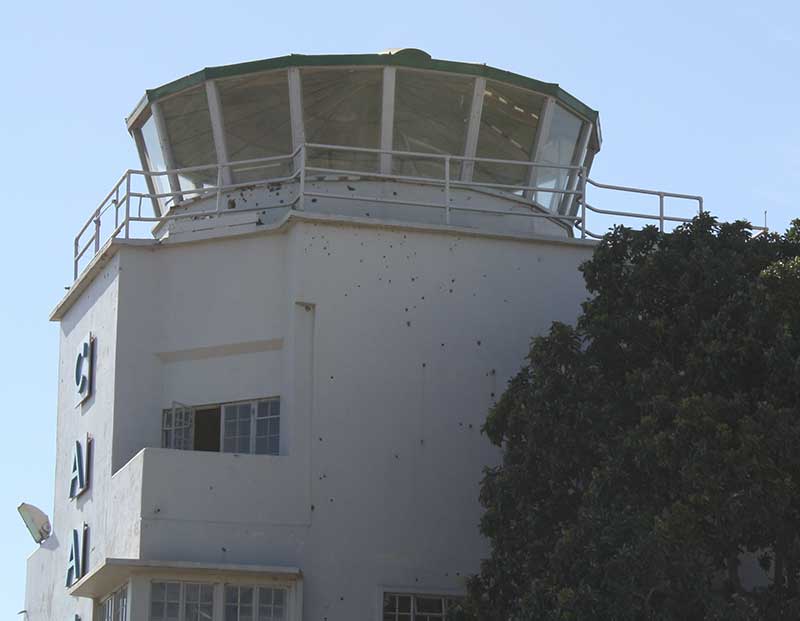
First documented operational use of a NFDD was by Israeli commandos during the raid at Entebbe in 1976. Bullet holes from the raid are visible in the old terminal building of the Entebbe International Airport in photo. Photo: US Army photo by Lt. Col. David Konop / Released.
The most widely employed fuzed training flashbang systems are the Pacem Defense ALS ALSDDTS Diversionary Device Training System, Combined Systems (CTS) Model 7290T and 7290MT Flash-Bang Training Systems and Safariland/Defense Technology Low Roll™ Distraction Device® Training Body and Training Fuzes.
Except for the special fuze and blue color, the fuzed training flashbangs by ALS, CTS and Defense Technology are identical in appearance and weight to the companies’ standard flashbangs that they’re designed to replicate. This makes them very popular with agencies that employ those companies’ less lethal products.
Popular in Europe, Blank Firing Impact Grenades are beginning to make their presence felt in the U.S. tactical community for training. Two such devices are Pacem Defense ALS TRMR-LE Training Device and Royal Arms International Impact Initiated Safety Flashbang FBG-MK4 NFDD Flash Bang Trainer.
The ALS TRMR-LE Training Device has a reloadable body that can be reloaded up to 250 times with the ALS1208 12 gauge Bore Thunder cartridge. The body of the TRMR- LE incorporates a safety button that must be engaged to twist the top section to arm, which functions similar to a standard firearm safety. Upon deployment, the device’s kinetic energy causes the wobble top to move and drive the firing pin into the primer of the cartridge. The TRMR-LE has been safety tested to withstand a ten-foot drop (in the safe position).
After deployment, the base is removed to expel the spent cartridge and reload and reassembled for next use. The Bore Thunder cartridges produce approximately 172 dB at five feet. The TRMR-LE can be configured as an irritant/marking powder dispersal system using a .68 caliber ball, such as a PepperBall from United Tactical Systems (UTS). The TRMR-LE is available in a range of colors (including training blue) to suit different mission profiles.
NFDDs have proven to be of extremely low
lethality over many years of tactical use, several
deaths have been attributed to their use
Royal Arms International’s new FBG-MK4 NFDD Flash Bang Trainer represents a major overhaul of its predecessor, the FBG-MK3. All aspects have been redesigned for even greater performance. The FBG-MK4 is engineered to withstand the harshest environments. It incorporates many improvements as a result of input from top-level operators.
The FBG-MK4 has a reloadable body that’s designed to be used with either Royal Arms 12 gauge FBC Flash Bang Cartridges or with standard 209 shotshell primers using the included adapter. It incorporates a pull-ring and spoon (“fuze” handle) for safety. It also employs a wobble top that utilizes the kinetic energy from impact to drive the firing pin into the primer. The FBG-MK4 has a black Melonite® finished body for durability and high visibility replaceable spoons. The spoons are available in yellow, blue and red.
Different colored spoons can be utilized to indicate different loading the different loads. For example a yellow spoon for the FBC Flash Bang Cartridges and a blue spoon for the 209 primers. The FBG-MK4 has a two-year unlimited warranty.
The FBC Flash Bang Cartridges produce 175 dB at five feet. The 209 primers produce 118 dB at five feet. The 209 primers definitely are the most cost effective way to conduct NFDD training, running only around 5¢ each.
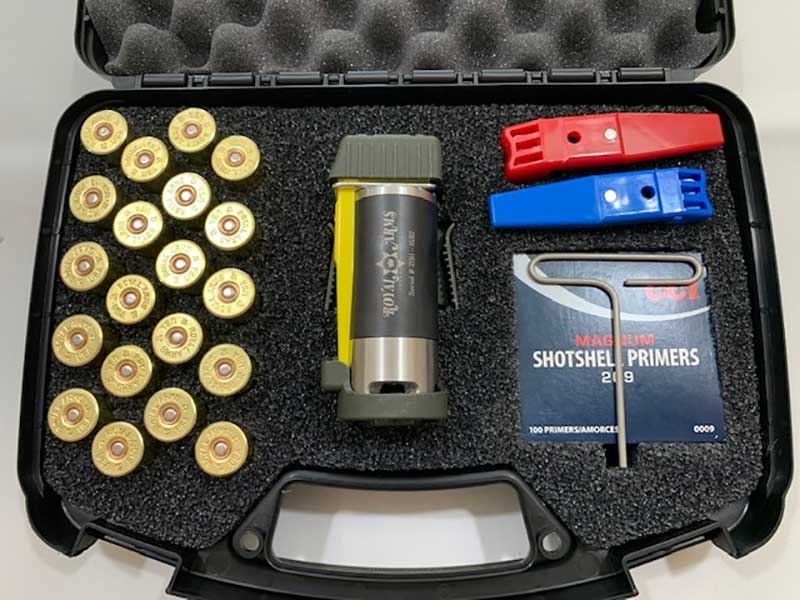
Royal Arms FBG-Mk4 comes in two versions the Basic Kit and Advanced Kit (shown). FBG-MK4 can use either Royal Arms 12 gauge FBC Flash Bang Cartridges or standard 209 shotshell primers. Photo: Royal Arms International.

Ring’s BLUEGUNS FSFBCTS Flash Bang CTS-7290 is an inert, detailed replica of the CTS 7290 Flash Bang. Photo: Ring’s Manufacturing.
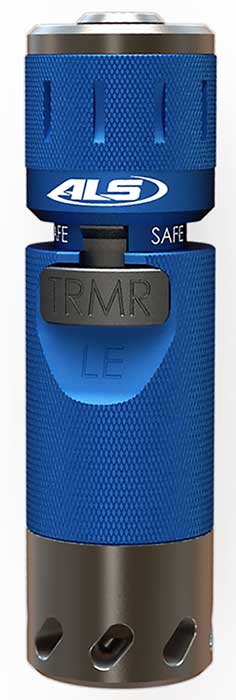
ALS TRMR-LE Training Device. It can be reloaded up to 250 times with ALS1208 12 gauge Bore Thunder cartridges. Photo: AMETEC Less-Lethal Systems.
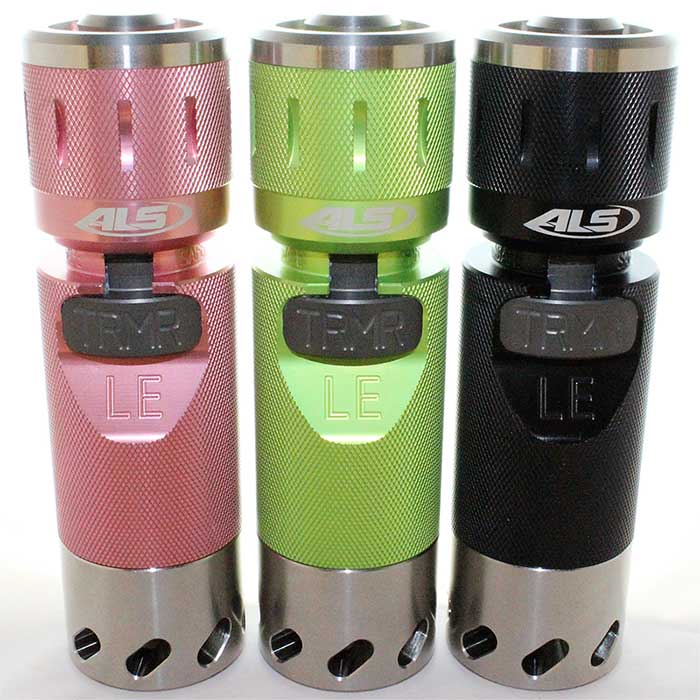
ALS TRMR-LE Training Device is available in a variety of colors to meet different operational needs. Training blue is also available but not shown in photo. Photo: AMETEC Less-Lethal Systems.
NON-PYROTECHNIC TRAINING DEVICES
The non-pyrotechnic devices currently on the market were developed for airsoft and paintball. Due to the nature of gases, pneumatic flashbang simulators have temperature dependent performance to varying degrees. Some can be very unreliable, especially in cold weather. Per use costs typically run between $2.50 and $5.00, depending on the device.
HEARING SAFE
All of the pyrotechnic and non-pyrotechnic devices mentioned in the article are loud enough for effective training but (except for the use of the ALS1208 12 gauge Bore Thunder cartridges and 12 gauge FBC Flash Bang Cartridges) not so loud as to mandate hearing protection. This makes them ideal for role-playing scenario-based force-on-force training. Another big plus is that training can be conducted in more locations than would be possible with a higher dB output.
CONCLUSION
To sum it all up, realistic NFDD training has never been more affordable. Today’s NFDD training options allow teams to train more often, in more places and with much greater safety than has been the case in the past.
SOURCES
PACEM DEFENSE ALS
www.lesslethal.com
COMBINED SYSTEMS
www.combinedsystems.com
RING’S MANUFACTURING
www.blueguns.com
ROYAL ARMS INTERNATIONAL
www.royalarms.com
SAFARILAND GROUP/DEFENSE TECHNOLOGY
www.defense-technology.com
UNITED TACTICAL SYSTEMS, LLC.
www.pepperball.com


 (No Ratings Yet)
(No Ratings Yet)